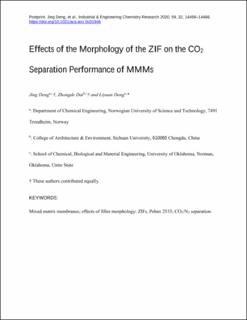| dc.contributor.author | Deng, Jing | |
| dc.contributor.author | Dai, Zhongde | |
| dc.contributor.author | Deng, Liyuan | |
| dc.date.accessioned | 2020-09-07T07:43:28Z | |
| dc.date.available | 2020-09-07T07:43:28Z | |
| dc.date.created | 2020-09-03T14:04:11Z | |
| dc.date.issued | 2020 | |
| dc.identifier.citation | Industrial & Engineering Chemistry Research. 2020, 59 (32), 14458-14466. | en_US |
| dc.identifier.issn | 0888-5885 | |
| dc.identifier.uri | https://hdl.handle.net/11250/2676534 | |
| dc.description.abstract | In this study, three zeolitic imidazolate frameworks (ZIFs) with different shapes—particles (0D), microneedles (1D), and leaves (2D)—were synthesized by tuning the polymeric additives. These ZIFs have been dispersed into a Pebax 2533 matrix with a loading varying from 0 to 20 wt %. The resultant mixed matrix membranes (MMMs) have been systemically characterized by various techniques. A mixed gas permeation experiment was also employed to evaluate the CO2 separation performance. The results show that there exists an optimal ZIF loading for these three series of membranes, but the values are highly dependent on the morphologies of the added ZIFs. The membranes containing ZIF particles and microneedles display the highest CO2 permeability and CO2/N2 selectivity simultaneously at 10 wt % loading, while a much lower loading, that is, ∼5 wt %, is the optimized value for ZIF leaves. Moreover, the increment in CO2 permeability is related to the ZIFs’ morphology and the order is 0D < 1D < 2D. On the other hand, the effects of the morphology on selectivity seems to be the opposite, with the ZIF of the 0D structure showing the highest selectivity. Moreover, the influences of adding ZIF fillers on the performances of the resultant MMMs under varied operating temperatures and the feed pressures were also investigated. The membrane with a 10 wt % 1D ZIF shows the highest increment in CO2 permeability (727.4 Barrer) with a CO2/N2 selectivity of ∼14 at 60 °C. | en_US |
| dc.language.iso | eng | en_US |
| dc.publisher | American Chemical Society | en_US |
| dc.title | Effects of the Morphology of the ZIF on the CO2 Separation Performance of MMMs | en_US |
| dc.type | Peer reviewed | en_US |
| dc.type | Journal article | en_US |
| dc.description.version | acceptedVersion | en_US |
| dc.source.pagenumber | 14458-14466 | en_US |
| dc.source.volume | 59 | en_US |
| dc.source.journal | Industrial & Engineering Chemistry Research | en_US |
| dc.source.issue | 32 | en_US |
| dc.identifier.doi | 10.1021/acs.iecr.0c01946 | |
| dc.identifier.cristin | 1827096 | |
| dc.relation.project | Norges forskningsråd: 254791 | en_US |
| dc.description.localcode | Locked until 17.7.2021 due to copyright restrictions. This document is the Accepted Manuscript version of a Published Work that appeared in final form in [JournalTitle], copyright © American Chemical Society after peer review and technical editing by the publisher. To access the final edited and published work see https://doi.org/10.1021/acs.iecr.0c01946 | en_US |
| cristin.ispublished | true | |
| cristin.fulltext | postprint | |
| cristin.fulltext | postprint | |
| cristin.qualitycode | 2 | |
